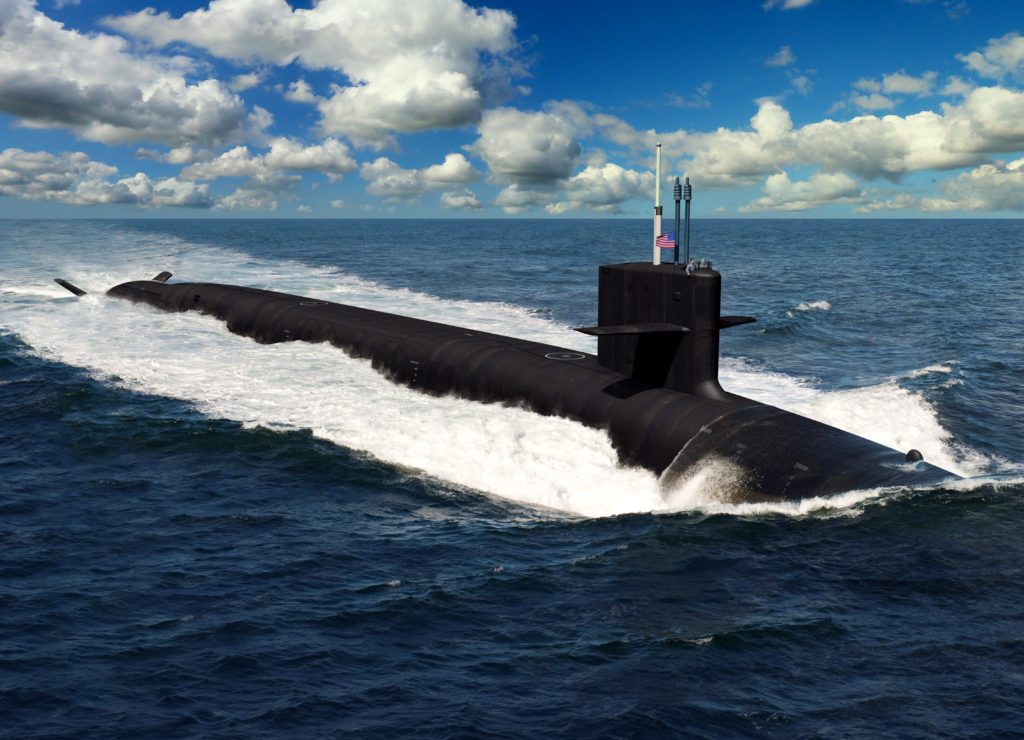
ARLINGTON, Va. — The nation’s submarine construction capacity built up for the Columbia-class ballistic-missile submarine (SSBN) program eventually will help the U.S. Navy to increase production of attack submarines (SSNs) to alleviate a shortage of attack boats, according to Navy and shipbuilding officials.
Under current planning, the Navy’s force structure studies have shown a need 70 SSN. The service currently fields about 50 SSNs, which are heavily used by regional combatant commanders, being only able to meet about 50% of their deployment requirements.
The Navy is building two Virginia-class attack submarines per year, and soon both, in the Block V version, will be equipped with the Virginia Payload Module, which will add cruise missile capacity and hypersonic missile capability to the force, among other payloads.
The Navy would like to procure three SSNs per year but currently is constrained by budget capacity to two per year while the Columbia-class SSBN is under construction. The Columbia program is a once-in-a-generation recapitalization program for the nation’s strategic deterrent force.
“We’re working very closely with industry to make sure we’re making the right long-term decisions, said Rear Adm. Bill Houston, director, Undersea Warfare, Division, Office of the Chief of Naval Operations, who has been selected to be the Navy’s next commander, Submarine Forces, speaking in a pre-recorded webinar of the Navy League’s Sea-Air-Space Prequel.
“We also have to look at it from a budget aspect [and] maintenance capability,” Houston said. “What our concern is that if you go to three [SSNs] per year in trying to peak out [the submarine force] with Virginia — with a 33-year life of ship — when you start building three per year, you’re ending up with a force structure of 99. So, as we’re reconstituting Columbia, and building two Virginias per year, when [construction of] the last Columbia hull commences in ’35, we’re going to have significant capacity then. So, we have the capability to go to three per year right now. The issue is that we’ve got Columbia under construction, so we’re just doing that balancing right now. Working with industry right now to make sure that stability that’s out there for [submarine builders], we’re trying to avoid those peak/troughs.
“As part of our private [shipyard submarine maintenance] plan, that workforce is highly skilled and we can’t go from periods when we have the private industry doing maintenance and then it’s not doing maintenance, because that is a fragile skillset,” he said.
Houston pointed out that stability in work orders is key to shipyard health and performance.
“We’re capable of going to three Virginias [per year] right now, [but] it would impact Columbia, so we’re concentrating on doing the Columbia and two Virginias per year,” he said. “We’re looking [at] how we can get up to three, but we’re sure that when that last Columbia hull is under construction, we’re going to have significant capacity.”
Houston noted that a Block V Virginia SSN displaces 10,000 tons submerged, equating to about half that of the Columbia SSBN, so every Columbia equates to two Virginia SSNs in displacement. Accordingly, with one Columbia and two Block V Virginias under construction, “we’re essentially building the equivalent of four Virginias,” he said.
“So, the capacity is there,” he said. “It’s more about the stability and avoiding the peaks and troughs.”
“I think our industrial base is somewhat fragile as we’ve gone from low-rate production in the 90s to now a two-per-year Virginia, a two-plus-one Virginia and Columbia,” said Kevin Graney, president of General Dynamics Electric Boat, whose company, teamed with Huntington Ingalls Newport News Shipbuilding, is building the Columbia-class SSBN. “That’s requiring us to bring in an awful lot of new suppliers across the industrial base in order to support that.”
Graney also said Electric Boat has been investing in additional facilities including construction halls and laid-out space in Groton, Connecticut, and Quonset Point, Rhode Island; upgrading a floating drydock from which the Columbia will be launched; and purchasing a new transport barge. The company has invested “about $250 million in training programs over the last five years and we’re developing active learning shipyards within the shipyards that have proven effective in improving our proficiency.”
- SECNAV Advocates Increased Legal Immigration to Increase Shipbuilder Workforce - April 23, 2024
- Insitu Going Strong at 30, Focusing on Maritime Operations - April 8, 2024
- Navy Awards Boeing Additional Funds for MQ-25 Drones for Testing - April 3, 2024






